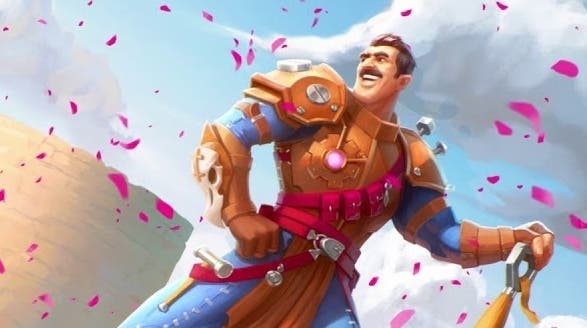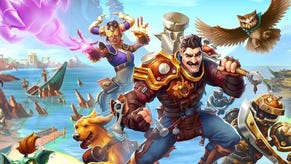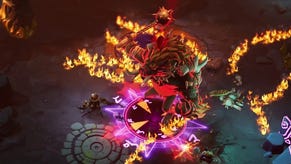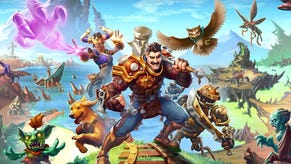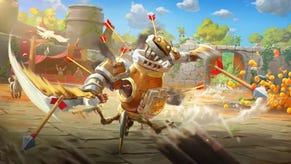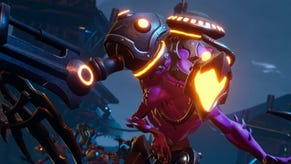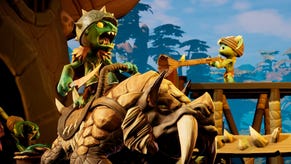Torchlight 3: The big interview
Beaming.
Torchlight 3 feels like it's come out of nowhere because in many ways it has. For a long time it was known as Torchlight Frontiers. It wasn't a codename but a name for something fundamentally different to the Torchlight games which had come before. It was free-to-play. But the people playing the alpha didn't like it and, truth be told, the developer didn't either, so late last year, big, bold changes were made. The studio went dark and when it reemerged in January, it announced a remarkable turnaround. No longer did the game have a free-to-play heart. It, and all its wiring, had been ripped out and replaced by a buy-once, premium design. No longer was the game fundamentally different to the Torchlights which came before it. No longer was the game Torchlight Frontiers. It was, instead, Torchlight 3.
And people loved it.
"We had no idea the name part itself meant so much to people." I'm talking to Tyler Thompson, co-founder of Echtra Games and co-lead of Torchlight 3, whose credits stretch back to being co-lead on Diablo 2 expansion Lord of Destruction, with his Torchlight 3 co-lead Max Schaefer. How things circle back around, eh!
"Honestly it was on a knife's edge as to whether we would change the name of the game or not. And we delayed our update and had people rush to figure out how to change all of our media and content at the last minute. 'Do we have an animated cinematic? Can we make a Torchlight 3 logo in time?' It was this mad scramble and we weren't even sure we wanted to do it. And suddenly people were like, 'Well I wasn't interested in your idea for this Torchlight Frontiers thing but now it's called Torchlight 3, I'm in!'"
A lot has changed since the game was known as Torchlight Frontiers. Various things weren't working. Mainly, the game was designed around conquering frontiers rather than playing through a story. Frontiers were areas themed around enemy types like goblins, and in those areas you had separate, distinct progression systems. In the goblin area you'd get goblin armour, for example, and skills to deal with goblins, which had the unhappy side effect of when you went to a new area being totally unprepared, as if starting from scratch.
It was a way of stretching out content to keep free-players playing, but it wasn't fun. It was boring and there was no variation. "It was awful," says Thompson. As were public areas where enemies respawned, because since when do enemies respawn in an action-RPG? Not being able to clear out an area bogged you down. It was weird, and it was boring. So they changed it.
They repurposed frontiers into acts and ran a linear story through them, and made all the myriad changes which came with it, and in the process, gained control, finally, of pacing. "It went from, 'This is painful to play - I'm having trouble doing my job and going back and playing this,' to, 'Oh this is good. This is good - I hardly notice the time going by.
"This game is not recognisably similar to the thing we had 18 months ago," he adds, "and that's largely due to our fans telling us, 'That thing you tried is bad. You could do better over here.' And us actually being willing to go, 'You know what? Let's reconsider.'"
What is Torchlight 3, then? It's an action RPG as you expect, like Torchlight, like Diablo, where you run around, whack stuff and get loot, levels, power. You know the kind of game. But Torchlight has always been quirky.
Take the classes, for instance. They aren't wizard, warrior, mage, and rogue. "They're not in the middle of the dart board." They are Forged and Railmaster, classes which, respectively, are a steam-powered robot and an engineer who summons trains. And while the Dusk Mage and Sharpshooter look familiar, they're apparently weird underneath. (That's it for launch by the way but they hear you asking for pure melee and summoner classes.)
Torchlight has pets; Torchlight is famed for having pets, and they fight with you and gain some power and equipment like you. But more importantly they take your loot back to town. It's one of the most famous features in the Torchlight series and one, I'm surprised to find out, Thompson hates! "I hate that feature!" he says. "It breaks the pacing. Commercial breaks are a healthy thing for people ... sending your pet to town is just like fast-forwarding through the commercial."
Nevertheless, pets are in Torchlight 3. "There's no way we could make a Torchlight game without it; that is a requirement. But I still hate it."
And like other games, Torchlight 3 has multiplayer, online for up to four people, or an offline single-player campaign. Couch co-op is a no for launch and iffy for ever being included. "I wish there was a little button in Unreal to turn that on but there isn't," says Thompson. "We did not build it from the beginning so adding that later has been just too big of a hill to climb. I'm not going to even put out a hope of that for launch, I'm sorry. It's just too big.
"If the game goes really well... We like to say, 'In the fullness of time, all things are possible,' and it's certainly something we've looked at and specced out, but we saw the amount of work it's going to be and we don't see that [happening] in the near term."
Sniff.
And Torchlight 3 has some new things. It has a new relic system we aren't allowed to know much more about yet, but it has a new fort system we can talk about, so...
Forts
Forts are new to Torchlight as a series and they're a form of player-housing, your home hubs - places you will build and upgrade structures which offer important buffs and services. You'll get yours in act one.
For instance, you can plant a luck tree which will give you - as all monuments do - an account-wide bonus to, in this case, luck. But donate items to it (the better the item, the better the donation) and in time it will grow, upgrade, and the sapling will eventually become, as Thompson puts it, "a giant cherry tree of magicness", and grant you even more luck.
Forts are also where you will be able to respec using Respectacle points, although note: respeccing will be a rare occurrence. "On the spectrum of how much can we respec? We are on the old-fashioned, Diablo 2-style end of the spectrum, with some of these points showing up. If I reach level 60, I might have seen 20 of those points," he says. "We want players to feel like they have a character with an identity and strategy that has picked a path and is going on that path and this is who this is. Not everyone loves that and I get that but that's the game we're making."
Forts are also places where you will have a reliquary for your relics, and where you can craft, store things and swap pets. And of course you can tinker with your fort's layout and design to your heart's content. It's not a requirement but you may want pretty it up when you see other people's forts, because in Torchlight 3, you will see other people's forts when you run through passageways between hub areas in the main game.
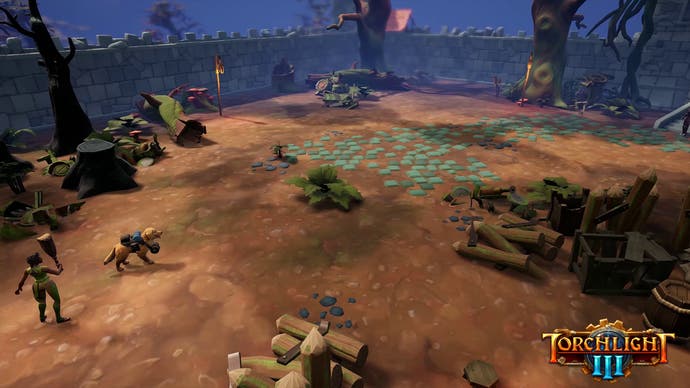
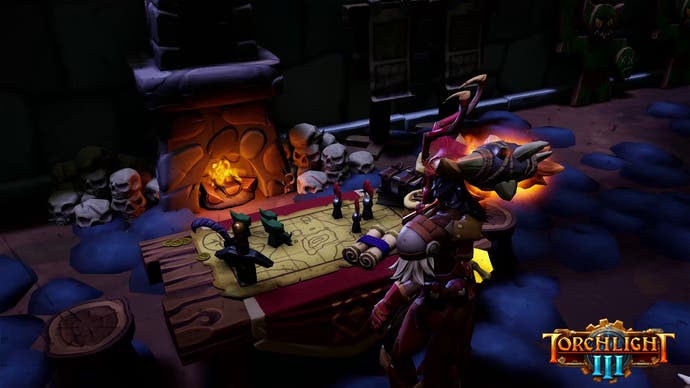
The forts you encounter in passageways will be pretty much plucked at random, although there's some code to ensure you see forts people have spent some time on, not lousy default forts. You see their name, you go in and you interact with buildings there, which means yes, you can receive temporary buffs from the monuments they have. You may also be able to access more advanced things you haven't got yet, like enchantments, as well as do rote stuff like swap pets and sort your storage. It's a pit stop along the way.
"It's always a little bit risky or weird when you put another style of game mechanic inside a game that already has a well known following or style of play," says Thompson. "When we aim to entice or help action-RPG players enjoy the game, we're not trying to do it by forcing them to play The Sims decorating game at the same time."
(Tyler Thompson worked on the Sims for a while so he's not bashing it, he just knows it's not for everyone.)
"So no," he adds, "you don't have to do a whole lot." But if you want to min-max, and let's face it who doesn't? Then you will need to at least place buildings so you can interact with them and level up, but where you place them is completely up to you - you can slap them down anywhere and be done with it if you want.
Forts are also places you and your friends can hang out. You don't need to wait for their fort to appear in a passageway: as soon as you're partied, you can use a portal - a "fortal" they call it - to get to their fort. And importantly, "Some of the endgame is going to be anchored in them," Thompson says cryptically. "It would make a lot of sense for a party to go to a fort, hang out there, have whoever the fort's owner is kick off what they're going to do, and go from there."
Battle passes
Another notable new feature will be a kind of battle pass system called Contracts which you use accrued Fame to gradually unlock. Fame has been a longstanding part of Torchlight, a kind of reward currency earned for killing champions or bosses or finishing quests.
"The Contracts look a lot like battle passes," Thompson says. "We have three different battle pass Contract things that you can pick from with different kinds of rewards, and as you level up with Fame through them, it unlocks a reward every level, or a collection of rewards at some levels. And then, because these are action-RPGs people play for hundreds or thousands of hours, we put at the end of every Contract a loop of six rewards you can just keep repeating, which are randomised but still give you a way to keep getting things."
Importantly, you do not buy these Contracts because they're included with the game and you can switch between them at will.
It sounds promising, doesn't it? But it also sounds as though some of the things are remnants of a free-to-play design. Tyler Thompson doesn't deny this. He admits the forts were a way to get free players invested in the game. How well they end up working in a premium game we only have assurances to go on, and why should we believe him - why should we trust Echtra Games?
Echtra Games isn't Runic Games after all, the creator of Torchlight. It's a studio only a few years old. But the Runic ties are strong, not least because Echtra co-founder Max Schaefer was also a co-founder of Runic. Thompson himself never worked there but in a weird roundabout way, he hired some of the people who did - Runic Games once having been Flagship Studios Seattle (which made Hellgate London, another action-RPG and another long and winding story), and Flagship was a company Thompson worked for.
The ties to Runic were so strong Echtra would take builds of Torchlight Frontier there to show every couple of months. "They had some of their artists and animators at Runic helping us build art as they were winding down from Hob," Thompson says. "Unfortunately Runic fell apart and is now gone, and that's a whole other story, but nonetheless we were connected to them, we were working with them, we had their blessing, we showed our stuff to them as we were working on it, and now we're carrying the torch forward for Torchlight."
What I also find heartening is how long Tyler Thompson and Max Schaeffer, and many others at Echtra Games, have been making action-RPGs. These people are caked in them. Tompson and Schaefer co-led development of Diablo 2: Lord of Destruction at Blizzard, as I said, and they made Hellgate: London whatever you may think of it. Thompson even worked on Diablo 3 for a couple of years, a drop in the ocean of its total thirteen-year development, "And I'm not joking with that number," he says.
"Honestly, Echtra Games is a 'bringing the band back together' event from a lot of Blizzard North people," he says. They've got the art director who made all the environments for Diablo 2, the composer who did the music for Diablo 2 - and Torchlight - and others. These are people who know in their bones how action-RPGs should work, how they need to feel, from the moment you click to the moment damage happens, to the moment the loot spews out and you see what it is.
Echtra isn't the biggest team in the world, they're around 37 people and all working on Torchlight 3, but being underdog has never held Torchlight back in the past. And they're all well versed in working from home, which means even with Coronavirus rampaging, they're still confident of a 2020 release.
"We feel like we're definitely on track for a release this year," Thompson says. "We haven't said when - people have been guessing. What we've announced is a PC release this year with consoles coming afterwards."
I can't wait.
